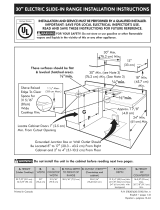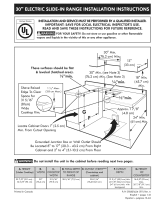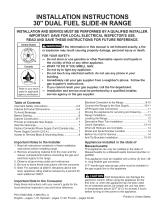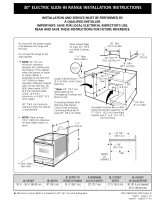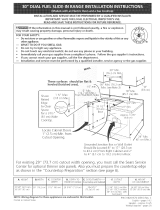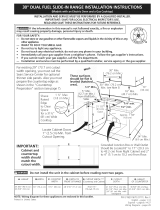
Product Dimensions
\
X
A
\ c
A. 21%e" (54.! cm)
B. 30%6" (77.1 cm)
36%6" (92.3 cm)
C. 27/8"(7.3 cm)
Installation Clearances
C
A. 30" (76.2 cm) on 30" (76.2 cm) models; 36" (91.4 cm) on
36" (91.4 cm) models
B. Combustible area above countertop (shown by dashed box above)
C. 30" (76.2 cm) minimum clearance between top of cooktop platform
and bottom of unprotected wood or metal cabinet (24" [61 cm]
minimum clearance if bottom of wood or metal cabinet is protected
by not less than V4"[0.6 cm] flame retardant millboard covered with
not less than No. 28 MSG sheet steel, 0.015" [0.04 cm] stainless
steel, or 0.024" [0.06 cm] aluminum or 0.020" [0.05 cm] copper)
D. 13" (33 cm) recommended upper cabinet depth
E. 2"(5.! cm)
F. 20_2" (52 cm)
G. 18" (45.7 cm) minimum clearance from upper cabinet to countertop
within minimum horizontal clearances to cooktop
H. Junction box or outlet," !2" (30.5 cm) minimum from bottom of
countertop; 10" (25.4 cm) from right side of cabinet
I. !4_2" (36.8 cm) on 15" (38.1 cm) models; 29_/2'' (74.9 cm) on
30" (76.2 cm) models; 35_2" (90.2 cm) on 36" (91.4 cm) models
J. 1" (2.5 cm) minimum distance to nearest left and right side
combustible surface above cooktop
K. !_/2'' (3.8 cm) max. counter thickness on 15" (38.1 cm) models. See
following illustration.
L. !" (2.5 cm) minimum clearance between back waft and countertop
NOTE: After you make the countertop cutout, some installations
may require notching down the base cabinet side walls to clear
the burner box. To avoid this modification, use a base cabinet
with sidewalls wider than the cutout.
If cabinet has a drawer, a 3" (7.6 cm) depth clearance from the
countertop to the top of the drawer (or other obstruction) in base
cabinet is required.
When installing a hood above the cooktop, follow the hood
instructions for dimensional clearances above the cooktop
surface.
Electrical Shock Hazard
Disconnect power before servicing.
Use 8 gauge copper wire.
Electrically ground cooktop.
Failure to follow these instructions can result in death,
fire, or electrical shock.
If codes permit and a separate ground wire is used, it is
recommended that a qualified electrical installer determine that
the ground path and wire gauge are in accordance with local
codes.
Do not ground to a gas pipe.
Check with a qualified electrical installer if you are not sure the
cooktop is properly grounded.
Do not have a fuse in the neutral or ground circuit.
Make sure that the electrical connection and wire size are
adequate and in conformance with the National Electrical Code,
ANSl/NFPA 70-latest edition or CSA Standards C22.1-94,
Canadian Electrical Code, Part 1 and C22.2 No. O-M91-1atest
edition, and all local codes and ordinances.
A copy of the above code standards can be obtained from:
National Fire Protection Association
One Batterymarch Park
Quincy, MA 02269
CSA International
8501 East Pleasant Valley Road
Cleveland, OH 44131-5575
Before You Make the Electrical Connection:
To properly install your cooktop, you must determine the type of
electrical connection you will be using and follow the instructions
provided for it here.
• A 4-wire or 3-wire, single phase, 240 volt, 60 Hz., AC only
electrical supply is required on a separate, 40-amp circuit,
fused on both sides of the line.
The cooktop should be connected directly to the junction box
through flexible, armored or nonmetallic sheathed, copper
cable. The flexible, armored cable extending from the fuse
box or circuit breaker box should be connected directly to the
junction box.







